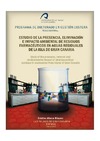Identificador persistente para citar o vincular este elemento:
https://accedacris.ulpgc.es/jspui/handle/10553/41794
| Campo DC | Valor | idioma |
|---|---|---|
| dc.contributor.advisor | Santana Rodríguez, José Juan | - |
| dc.contributor.advisor | Sosa Ferrera, María Zoraida | - |
| dc.contributor.advisor | Doña Rodríguez, José Miguel | - |
| dc.contributor.author | Afonso Olivares, Cristina | - |
| dc.date.accessioned | 2018-08-20T11:47:38Z | - |
| dc.date.available | 2018-08-20T11:47:38Z | - |
| dc.date.issued | 2017 | en_US |
| dc.identifier.uri | https://accedacris.ulpgc.es/handle/10553/41794 | - |
| dc.description | Programa de doctorado: Gestión costera. | en_US |
| dc.description.abstract | En apenas los últimos veinte años ha aumentado la preocupación de la comunidad científica por la presencia de nuevos contaminantes, considerados emergentes, en los diferentes compartimentos ambientales, así como, sobre sus posibles consecuencias negativas para los seres vivos. Sin embargo, su control y regulación avanza muy lentamente, por lo que se necesita seguir investigando, sobretodo, el comportamiento de aquellos grupos de compuestos que son considerados una amenaza, con el fin de obtener los suficientes datos para poder concretar las medidas necesarias. En este sentido, los compuestos farmacéuticos, los cuales son usados de manera continua y extensa, son persistentes debido a su baja biodegradabilidad y presentan una cierta toxicidad, han sido monitorizados y detectados en muestras hidrológicas, especialmente, debido a su ruta principal de entrada después de ser consumidos y excretados por humanos y animales. Este tipo de estudios no hubiese sido posible sin la existencia y desarrollo de metodologías analíticas cada vez más amigables con el propio medioambiente sin dejar de ser sensibles, selectivas y robustas. Sin embargo, aunque haya una gran disponibilidad de datos sobre la presencia de los fármacos en el medioambiente, todavía quedan zonas geográficas con características particulares donde no se han estudiado en profundidad... | en_US |
| dc.description.abstract | In just the last twenty years the scientific community concern have increased due to the presence of new pollutants, which are considered emerging, in the different environmental compartments, as well as, their possible negative consequences for living beigns. However, its control and regulation progress very slowly, so we need further research, especially, the behavior of those groups of compounds that are considered a threat, in order to obtain sufficient data to be able to specify the necessary mea sures. In this sense, pharmaceutical compounds, which are used continuously and extensively, are persistent due to their low biodegradability and have a certain toxicity, have been monitored and detected in hydrological samples, due to their main route of entry after their consumption and excretion by humans and animals. Such studies would not have been possible without the existence and development of analytical methodologies that are increasingly friendly to the environment, while being sensitive, selective and robust. However, although there is a high availability of data on the presence of drugs in the environment, there are still geographical areas with particular characteristics where they have not been studied in depth... | en_US |
| dc.language | spa | en_US |
| dc.subject | 330530 Alcantarillado y depuración de aguas | en_US |
| dc.subject | 330807 Eliminación de residuos | en_US |
| dc.subject | 330810 Tecnología de aguas residuales | en_US |
| dc.subject.other | Depuración de aguas residuales | en_US |
| dc.title | Estudio de la presencia, eliminación e impacto ambiental de residuos farmacéuticos en aguas residuales de la isla de Gran Canaria | en_US |
| dc.title.alternative | Study of the presence, removal and environmental impact of pharmaceutical residues in wastewater from island of Gran Canaria | en_US |
| dc.type | info:eu-repo/semantics/doctoralThesis | en_US |
| dc.type | Thesis | en_US |
| dc.type | Thesis | en_US |
| dc.type | Thesis | en_US |
| dc.type | Thesis | en_US |
| dc.type | Thesis | en_US |
| dc.type | Thesis | en_US |
| dc.type | Thesis | en_US |
| dc.contributor.departamento | Departamento de Química | en_US |
| dc.contributor.facultad | Facultad de Ciencias del Mar | en_US |
| dc.investigacion | Ciencias | en_US |
| dc.type2 | Tesis doctoral | en_US |
| dc.utils.revision | Sí | en_US |
| dc.identifier.matricula | TESIS-1488391 | es |
| dc.identifier.ulpgc | Sí | en_US |
| dc.contributor.programa | Programa Oficial de Doctorado en Gestión Costera | es |
| item.fulltext | Con texto completo | - |
| item.grantfulltext | open | - |
| crisitem.author.orcid | 0000-0002-3089-4549 | - |
| crisitem.author.fullName | Afonso Olivares, Cristina | - |
| crisitem.advisor.dept | GIR IUNAT: Análisis Químico Medioambiental | - |
| crisitem.advisor.dept | IU de Estudios Ambientales y Recursos Naturales | - |
| crisitem.advisor.dept | Departamento de Química | - |
| crisitem.advisor.dept | GIR IUNAT: Análisis Químico Medioambiental | - |
| crisitem.advisor.dept | IU de Estudios Ambientales y Recursos Naturales | - |
| crisitem.advisor.dept | Departamento de Química | - |
| crisitem.advisor.dept | GIR IUNAT: Fotocatálisis y espectroscopía para aplicaciones medioambientales. | - |
| crisitem.advisor.dept | IU de Estudios Ambientales y Recursos Naturales | - |
| crisitem.advisor.dept | Departamento de Química | - |
| Colección: | Tesis doctoral | |
Visitas
256
actualizado el 16-sep-2023
Descargas
487
actualizado el 16-sep-2023
Google ScholarTM
Verifica
Comparte
Exporta metadatos
Los elementos en ULPGC accedaCRIS están protegidos por derechos de autor con todos los derechos reservados, a menos que se indique lo contrario.
